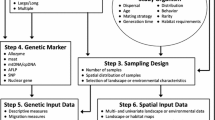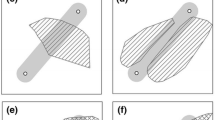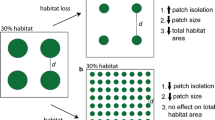Abstract
Ecological relationships between patterns and processes are highly scale dependent. This paper reports the first formal exploration of how changing scale of research away from the scale of the processes governing gene flow affects the results of landscape genetic analysis. We used an individual-based, spatially explicit simulation model to generate patterns of genetic similarity among organisms across a complex landscape that would result given a stipulated landscape resistance model. We then evaluated how changes to the grain, extent, and thematic resolution of that landscape model affect the nature and strength of observed landscape genetic pattern–process relationships. We evaluated three attributes of scale including thematic resolution, pixel size, and focal window size. We observed large effects of changing thematic resolution of analysis from the stipulated continuously scaled resistance process to a number of categorical reclassifications. Grain and window size have smaller but statistically significant effects on landscape genetic analyses. Importantly, power in landscape genetics increases as grain of analysis becomes finer. The analysis failed to identify the operative grain governing the process, with the general pattern of stronger apparent relationship with finer grain, even at grains finer than the governing process. The results suggest that correct specification of the thematic resolution of landscape resistance models dominates effects of grain and extent. This emphasizes the importance of evaluating a range of biologically realistic resistance hypotheses in studies to associate landscape patterns to gene flow processes.



Similar content being viewed by others
References
Balkenhol N, Gugerli F, Cushman SA, Waits LP, Coulon A, Arntzen JW, Holderegger R, Wagner HH, Arens P, Campagne P, Dale VH, Nicieza AG, Smulders MJM, Tedesco E, Wang H, Wasserman TN (2009) Identifying future research needs in landscape genetics: where to from here? Landscape Ecol 24:455–463
Bowcock AM, Ruiz-Linares A, Tomfohrde J, Minch E, Kidd JR, Cavalli-Sforza LL (1994) High resolution of human evolutionary trees with polymorphic micorsatellites. Nature 368:455–457
Corry RC, Nassauer JI (2005) Limitations of using landscape pattern indices to evaluate the ecological consequences of alternative plans and designs. Landscape Urban Plan 72:265–280
Coulon A, Cosson JF, Angibault JM, Cargnelutti B, Galan M, Morellet N, Petit E, Aulagnier S, Hewison AJM (2004) Landscape connectivity influences gene flow in a roe deer population inhabiting a fragmented landscape: an individual-based approach. Mol Ecol 13:2841–2850. doi:10.1111/j.1365-294X.2004.02253.x
Cushman SA (2006) Effects of habitat loss and fragmentation on amphibians: a review and prospectus. Biol Conserv 128:231–240. doi:10.1016/j.biocon.2005.09.031
Cushman SA, Landguth EL (in press) Spurious correlations and inference in landscape genetics. Mol Ecol
Cushman SA, McKelvey KS, Hayden J, Schwartz MK (2006) Gene-flow in complex landscapes: testing multiple models with causal modeling. Am Nat 168:486–499
Cushman SA, McGarigal K, Neel M (2008a) Parsimony in landscape metrics: strength, universality, and consistency. Ecol Indic 8:691–703
Cushman SA, McKelvey K, Flather C, McGarigal K (2008b) Testing the use of forest communities to evaluate biological diversity. Frontiers Ecol Environ 6:13–17
Cushman SA, McGarial K, Gutzwiller K, Evans J (2009) The gradient paradigm: a conceptual and analytical framework for landscape ecology, chap 5. In: Cushman SA, Huettman F (eds) Spatial complexity, informatics and wildlife conservation. Springer, Tokyo
Dupanloup I, Schneider S, Excoffier L (2001) A simulated annealing approach to define genetic structure of populations. Mol Ecol 58:2021–2036
Epperson BK, McRae B, Scribner K, Cushman SA, Rosenberg MS, Fortin M-J, James PMA, Murphy M, Manel S, Legendre L, Dale MRT (in press) Utility of computer simulations in landscape genetics. Mol Ecol
ESRI (1999–2008) ArcGIS: Release 9.3. Environmental System Research Institute, Redlands, CA
Francois O, Ancelet S, Guillot G (2006) Bayesian clustering using hidden Markov random fields in spatial population genetics. Genetics 174:805–816
Hargis CD, Bissonette JA, David JL (1998) The behavior of landscape metrics commonly used in the study of habitat fragmentation. Landscape Ecol 13:167–186
Hess G, Bay JM (1997) Generating confidence intervals for composition-based landscape indexes. Landscape Ecol 12:309–320
Holderegger R, Wagner HH (2008) Landscape genetics. Bioscience 58:199–207
Landguth EL, Cushman SA (2010) CDPOP: an individual-based, cost-distance spatial population genetics model. Mol Ecol Resour 10:156–161
Lausch A, Herzog F (2002) Applicability of landscape metrics for the monitoring of landscape change: issues of scale, resolution and interpretability. Ecol Indic 2:3–15
Levin SA (1992) The problem of pattern and scale in ecology. Ecology 73:1943–1967
Li H, Wu J (2004) Use and misuse of landscape indices. Landscape Ecol 19:389–399
Manel S, Schwartz MK, Luikart G, Taberlet P (2003) Landscape genetics: combining landscape ecology and population genetics. Trends Ecol Evol 18:189–197
Mantel N (1967) The detection of disease clustering and a generalized regression approach. Cancer Res 27:209–220
McGarigal K, Cushman SA (2005) The gradient concept of landscape structure. In: Wiens J, Moss M (eds) Issues and perspectives in landscape ecology. Cambridge University Press, Cambridge, pp 112–119
McRae BH (2006) Isolation by resistance. Evol Int J Org Evol 60:1551–1561
McRae BH, Beier P (2007) Circuit theory predicts gene flow in plant and animal populations. Proc Natl Acad Sci USA 104:19885–19890. doi:10.1073/pnas.0706568104
Neel MC, Cushman SA, McGarigal K (2004) Behavior and stability of landscape metrics across controlled gradients of landscape structure. Landscape Ecol 19:435–455
Pritchard JK, Stephens M, Peter D (2000) Inference of population structure using multilocus genotype data. Genetics 155:945–959
R Development Core Team (2009) R: a language and environment for statistical computing. R Foundation for Statistical Computing, Vienna, Austria. ISBN 3-900051-07-0. http://www.R-project.org
Riitters KH, O’Neill RV, Hunsaker CT, Wickham JD, Yankee DH, Timmins SP, Jones KB, Jackson BL (1995) A factor analysis of landscape pattern and structure metrics. Landscape Ecol 10:23–39
Saura S, Martinez-Millan J (2001) Sensitivity of landscape pattern metrics to map spatial extent. Photogramm Eng Remote Sens 67:1027–1036
Schwartz MK, Copeland JP, Anderson NJ, Squires JR, Inman RM, McKelvey KS, Pilgrim KL, Waits LP, Cushman SA (2009) Wolverine gene flow across a narrow climatic niche. Ecology 90:3222–3232
Segelbarcher G, Cushman SA, Epperson BK, Fortin M-J, Francois O, Hardy OJ, Holderegger R, Manel S (2010) Applications of landscape genetics in conservation biology: concepts and challenges. Conserv Genet. doi:10.1007/s10592-009-0044-5
Shao G, Liu D, Zhao G (2001) Relationships of image classification accuracy and variation of landscape statistics. Can J Remote Sens 27:33–43
Shen W, Wu J, Ren H (2003) Effects of changing spatial extent on landscape pattern analysis. Acta Ecol Sin 23:2219–2231
Smouse PE, Long JC, Sokal RR (1986) Multiple regression and correlation extensions of the Mantel test of matrix correspondence. Syst Zool 35:627–632
Storfer A, Murphy MA, Evans JS, Goldberg CS, Robinson S, Spear SF, Dezzani R, Delmelle E, Vierling L, Waits LP (2007) Putting the ‘‘landscape’’ in landscape genetics. Heredity 98:128–142
Thompson CM, McGarigal K (2002) The influence of research scale on bald eagle habitat selection along the lower Hudson River, New York (USA). Landscape Ecol 17:569–586
Tischendor L (2001) Can landscape indices predict ecological processes consistently? Landscape Ecol 16:235–254
Turner MG, O’Neill RV, Gardner RH, Milne BT (1989) Effects of changing spatial scale on the analysis of landscape pattern. Landscape Ecol 3:153–162
Wickham JD, Ritters KH (1995) Sensitivity of landscape metrics to pixel size. Int J Remote Sens 16:3585–3594
Wickham JD, O’Neill RV, Riitters KH, Wade T, Jones KB (1997) Sensitivity of selected landscape pattern metrics to land-cover misclassification and differences in land-cover composition. Photogram Eng Remote Sens 63:397–402
Wiens JA (1989) Spatial scaling in ecology. Funct Ecol 3:385–397
Wu J (2004) Effects of changing scale on landscape pattern analysis: scaling relations. Landscape Ecol 19:125–138
Wu J, Hobbs R (2002) Key issues and research priorities in landscape ecology: an idiosyncratic synthesis. Landscape Ecol 17:355–365
Wu J, Loucks OL (1995) From balance of nature to hierarchical patch dynamics: a paradigm shift in ecology. Q Rev Biol 70:439–466
Wu J, Jelinski DE, Luck M, Tueller PT (2000) Multiscale analysis of landscape heterogeneity: scale variance and pattern metrics. Geogr Inf Syst 6:6–19
Wu J, Shen W, Sun W, Tueller PT (2002) Empirical patterns of the effects of changing scale on landscape metrics. Landscape Ecol 17:761–782
Zhao W, Fu B, Chen L (2003) The effects of grain change on landscape indices. Quat Sci 23:326–333
Author information
Authors and Affiliations
Corresponding author
Rights and permissions
About this article
Cite this article
Cushman, S.A., Landguth, E.L. Scale dependent inference in landscape genetics. Landscape Ecol 25, 967–979 (2010). https://doi.org/10.1007/s10980-010-9467-0
Received:
Accepted:
Published:
Issue Date:
DOI: https://doi.org/10.1007/s10980-010-9467-0




